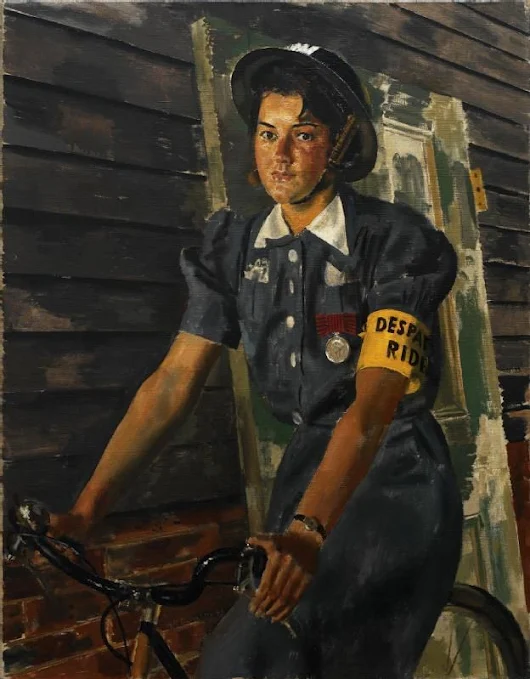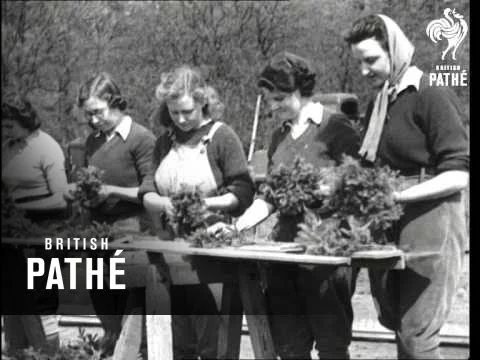.
Canning Machine, WI > .Women's Institute (1950-1959) - Pathé > .
The Women's Institute (WI) is a community-based organisation for women in the United Kingdom, Canada, South Africa and New Zealand. The movement was founded in Stoney Creek, Ontario, Canada, by Erland and Janet Lee with Adelaide Hoodless being the first speaker in 1897. It was based on the British concept of Women's Guilds, created by Rev Archibald Charteris in 1887 and originally confined to the Church of Scotland. From Canada the organisation spread back to the motherland, throughout the British Empire and Commonwealth, and thence to other countries. Many WIs belong to the Associated Country Women of the World organization.
The first WI in Britain was founded on the Isle of Anglesey in Wales in 1915. The idea for the WI came from Canada where the movement was formed in 1897 to help connect women in isolated rural areas.
By the outbreak of WW2 in 1939, the WI was a well-established pillar of rural life in Britain, with institutes in more than 5,500 villages. But its National Executive Committee initially struggled to decide whether the WI would be able to help with the war effort at all as they had taken a strong anti-war stance. The WI's Chairman, Lady Denman, realised that the WI's members would want to 'do their bit'. She suggested that the WI might be called upon to help with caring for evacuees and with rural food production.
These predictions proved correct. The WI made a significant contribution on the home front. In September 1939, over 1.5 million children, mothers and babies, elderly and disabled people were evacuated from Britain's major towns and cities to rural areas. As well as the evacuation of these vulnerable groups, many businesses and government departments also moved their staff to the countryside. Members of the WI in reception areas were active in billeting and receiving evacuees and helping to settle them into rural communities. WI members often organised activities such as country walks and tea parties to help keep evacuee children occupied and entertained. Early in 1939, members of the WI had also assisted those planning the Government's evacuation scheme by carrying out a survey of rural homes to find out how many households might be able to take evacuees. In 1941, they also published an influential report on their members' experiences of evacuation.
The National Savings Movement was a British mass savings movement that operated between 1916 and 1978 and was used to finance the deficit of government spending over tax revenues. The movement was instrumental during WW2 in raising funds to support the war effort. A War Savings Campaign was set up by the War Office to support the war effort. Local savings weeks were held which were promoted with posters with titles such as "Lend to Defend the Right to be Free", "Save your way to Victory" and "War Savings are Warships".
In January 1940, R M Kindersley, President of the National Savings Committee asked the WI to help raise the profile of the National Savings Campaign. Each branch was asked to display posters and distribute leaflets and to set up its own National Savings Scheme. Stotfold in Bedfordshire raised £8,190 (the equivalent of £283,000 today) in just two years.
The WI had run markets in rural areas since 1919 and in wartime, with food supplies scarce, these became an ever more valuable addition to rural towns and villages. WI markets sold surplus produce – mainly fruit and vegetables – from WI members, from smallholders and allotment holders. In a report on WI markets, the Ministry of Information concluded that they were 'business-like and practical examples of cooperative rural enterprise'. The WI also assisted the Women's Voluntary Service (WVS) distribute and sell pies to agricultural workers as part of the Rural District Pie Scheme.
After the fall of France in June 1940 it was no longer possible for Britain to import food from mainland Europe. This meant a drastic reduction in the availability of onions. The Ministry of Food tried to encourage commercial production in the UK but the first crop failed. People had to try to grow their own. The WI helped by organising the distribution of onion seeds and sets. The Oxfordshire WI harvested 13 tons in 1942. The National Federation of WIs also distributed tomato seeds and seed potatoes in large numbers and sold other seeds to their members at a preferential rate.
Oranges were scarce during the Second World War and, as they were an important source of Vitamin C, when available they were given as a priority to children over adults. But alternative sources of Vitamin C were needed. The WI and other voluntary organisations were asked to collect 500 tons of rosehips. These were used by pharmacists to make rosehip syrup which was very rich in Vitamin C. WI members in Oxfordshire also collected Foxgloves (Belladonna atropa) which were dried to make the drug digitalis, used for patients with heart conditions.
Making jam is probably one of the things that the WI is most famous for. But what is less well known is that during the Second World War, WI members made jam on an epic scale and made a significant contribution to Britain's food supplies. In 1939, realising that much of the fruit from the summer's bumper harvest might be wasted unless it were made into jam, WI's headquarters secured sugar supplies direct from the Ministry of Food. WIs across the country gathered in surplus fruit from gardens and allotments or growing wild. In their first wave of jam making, it is estimated that the WI saved 450 tons of fruit from rotting.
From 1940, the WI's jam making efforts escalated but came under increased supervision from the Ministry of Food. After the introduction of food rationing in January, there were restrictions on how and where jam could be sold. The supplies of sugar needed for jam making were tightly controlled and records had to be kept of all fruit preserved and sold. Preservation centres were set up in villages or near where fruit was harvested.
Some institutes were keen to look for new ways to preserve fruit and other produce and organised professional canning. This was a skill that had to be learnt and practised as faulty cans could explode. In August 1940, the Queen visited a WI canning centre at Hyde Heath in Buckinghamshire. Canning operations received a further boost when the American Federation of Business and Professional Women donated six mobile canning vans to the WI.
The first WI in Britain was founded on the Isle of Anglesey in Wales in 1915. The idea for the WI came from Canada where the movement was formed in 1897 to help connect women in isolated rural areas.
By the outbreak of WW2 in 1939, the WI was a well-established pillar of rural life in Britain, with institutes in more than 5,500 villages. But its National Executive Committee initially struggled to decide whether the WI would be able to help with the war effort at all as they had taken a strong anti-war stance. The WI's Chairman, Lady Denman, realised that the WI's members would want to 'do their bit'. She suggested that the WI might be called upon to help with caring for evacuees and with rural food production.
These predictions proved correct. The WI made a significant contribution on the home front. In September 1939, over 1.5 million children, mothers and babies, elderly and disabled people were evacuated from Britain's major towns and cities to rural areas. As well as the evacuation of these vulnerable groups, many businesses and government departments also moved their staff to the countryside. Members of the WI in reception areas were active in billeting and receiving evacuees and helping to settle them into rural communities. WI members often organised activities such as country walks and tea parties to help keep evacuee children occupied and entertained. Early in 1939, members of the WI had also assisted those planning the Government's evacuation scheme by carrying out a survey of rural homes to find out how many households might be able to take evacuees. In 1941, they also published an influential report on their members' experiences of evacuation.
The WI had run markets in rural areas since 1919 and in wartime, with food supplies scarce, these became an ever more valuable addition to rural towns and villages. WI markets sold surplus produce – mainly fruit and vegetables – from WI members, from smallholders and allotment holders. In a report on WI markets, the Ministry of Information concluded that they were 'business-like and practical examples of cooperative rural enterprise'. The WI also assisted the Women's Voluntary Service (WVS) distribute and sell pies to agricultural workers as part of the Rural District Pie Scheme.








